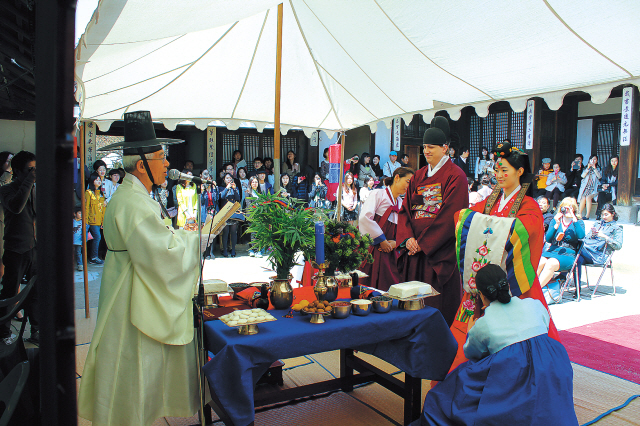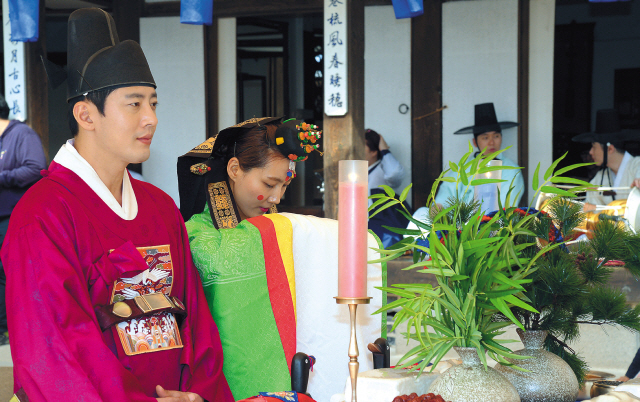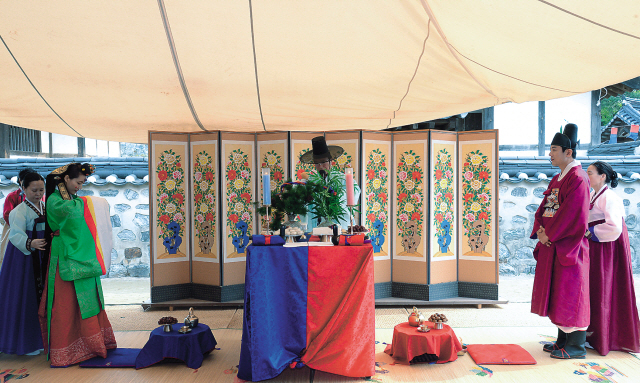뉴스속보 상세보기
 |
| A speaker presides over a couple’s traditional Korean wedding at Unhyeongung. (Korea Herald file photo) |
But the 31-year-old office worker chose to do something different for her big day ― choosing hanbok over a wedding gown and jokduri, a traditional coronet, over a tiara.
“I wanted to show my children, my grandchildren later in my life that I married their father not in a conventional wedding hall, but in a historic place where tradition is alive,” she said.
Kim married Daniel Kelley on April 21, in the courtyard of Unhyeong Palace in Jongno, central Seoul. The Joseon palace was the birthplace of King Gojong (1852-1919) and the royal residence where his wife Empress Myeongseong prepared their wedding.
Incorporating aspects of wedding ceremonies held by noble families during the Joseon era (1392-1897), the bride tied the knot dressed in beautifully embroidered red hanbok. The groom also wore traditional attire ― a gwanbok, which represented the man’s high social standing in the Joseon era.
Their wedding followed six ceremonial procedures of a Joseon wedding.
From jeonanrye, meaning the groom’s arrival to the bride’s house and his offering of a set of wooden geese to her mother as an oath of lifelong love, to hapgeunrye, the last part of the ceremony when the bride and the groom drink from separate halves of a gourd and then reunite the two cups, symbolizing that two have become one, each stage was a nod to the meaning of a devout marriage.
“I think it was breathtaking. Each session was really poetic and has inspired us to rethink of what a marriage life should be,” said the groom’s mother, who is from the United States.
 |
| A traditional wedding ceremony exhibition is held at Namsangol Hanok Village in Seoul last Sunday. (Ahn Hoon/The Korea Herald) |
 |
| Models performing as bride and groom greet each other at the beginning of a wedding ceremony exhibition at Namsangol Hanok Village in Seoul last Sunday. (Ahn Hoon/The Korea Herald) |
The Korean traditional wedding, called honrye in Korean, was the biggest event for every man and woman.
“Honrye signified a starting point of adulthood. Those who didn’t get married through this important ceremony, they were regarded as the most undutiful ones and were not accepted as part of their communities,” Jung Jong-soo, a historian wrote in his book titled “The Life of a Man.”
Unlike today, the ceremony took about three days because it was an important event not only for newlyweds and their families but for the entire village.
“It was a big feast for the community where people enjoyed humor and wit,” said Lee Seong-ho, Confucian scholar at Sungkyunkwan University in a previous interview.
Villagers used to make jokes about the groom, a newcomer to the bride’s house where honrye usually took place, or play pranks such as tripping him from behind.
But keeping the ceremony as formal as possible was a must. As soon as the groom arrived for the wedding of the marriage mostly arranged between families, a series of ceremonial procedures were followed.
In gwansewee, second of the six procedures, the bride and the groom washed their hands to keep body and soul pure and clean.
The bride and groom faced each other and bowed as a promise of commitment during a session called gyoberye and then rose up and poured cups of rice wine to take an oath to the heavens and the earth that they would become a happy couple.
In seobaewurye, they vowed to love and honor each other all their lives.
The six-stage ceremony may look old-fashioned and perhaps boring for inhabitants of fast-paced modern Korea where spiritual values are often ignored. But all of these sessions seemed to revive the meaning of a faithful marriage, Kim said.
“Unlike western weddings, my Korean traditional wedding had rituals that made us think what marriage really is. It was not an event mainly for show but filled with meaningful procedures that made us humble and faithful,” Kim said.
The wedding traditions originated in China, as Joseon society was influenced by the neighboring country’s Confucian culture, but the content and style differed between regions and families. It underwent a series of changes due to social and political transformations, according to Choi Eun-soo, a curator at the National Folk Museum of Korea.
“The traditional Korean wedding we know today is perhaps close to ceremonies held in late Joseon and the Japanese colonial era. Some of the rituals were modified in the modern era under the simplified family rite standards enacted by past governments,” she said.
Honrye cost a lot of money even in Joseon times, particularly for the bride’s family.
“The ceremony took place in the bride’s house. They had to prepare the food and drinks for the guests and also had to buy expensive wedding gifts for the groom’s family,” said Choi Soon-guen, senior curator at the museum.
For those who find it difficult to get married because of financial issues, state offices borrowed robes and other materials needed for the ceremony, Choi explained.
But it was not that difficult to get wedding attire for the bride and groom because each village had its own costumes for community members, he added.
The traditional Korean wedding may be smaller in scale than ceremonies of the past, but more young couples in Korea are considering the traditional event as an alternative to lavish and expensive modern weddings.
“Couples face financial issues because western weddings often cost a lot. The number of young couples who consider having a traditional Korean wedding is steadily growing because it is much more economical and unique,” a wedding manager in Seoul said.
The idea of a small wedding also grabbed attention from the international couple, Kim and Kelley.
“I really didn’t want to have a wedding that is filled with guests who I don’t really know. I invited only my close friends and family members. And getting married with the blessing of people I really love was amazing,” Kim said.
The traditional wedding was much cheaper than western style ceremonies which cost at least 10 million won ($9,000) for about 2-300 guests.
The couple spent less than 1 million won for the entire ceremony which even featured artists performing Korean traditional music for the guests, they said.
By Cho Chung-un (christory@heraldcorp.com)


